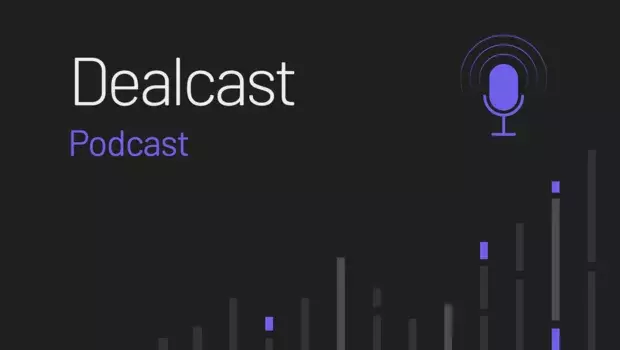Exploring Stakeholder Relationships in M&A Activity
Joining us on this week’s podcast is Simon Segal, director of Mergermarket Australia and a DealReporter consultant editor. Simon discusses a new book he’s co-written about stakeholder relationships around M&A activity, Reframing Mergers and Acquisitions around Stakeholder Relationships: Economic, Political and Social Processes (Routledge). Dealcast is presented by Mergermarket and SS&C Intralinks.
In this episode, you’ll learn about:
- How the shareholder value concept goes beyond ESG and sustainability
- Identifying the 12 key stakeholders in every M&A transaction
- How the framework differs from ESG, and why it was needed
- Six aspects of the framework and what inspired it
- Takeaways for M&A dealmakers
Transcript
[MUSIC PLAYING] JULIE-ANNA NEEDHAM: Welcome to Dealcast, the weekly M&A podcast presented to you by Mergermarket an SS&C Intralinks. I'm Julie-Anna Needham, a business journalist who has been covering M&A for a decade. For this episode, I'm joined by Simon Segal, director of Mergermarket Australia and a Dealreporter consulting editor. We're going to be finding out about a book that Simon's written which is based on his Ph.D. thesis. It's called Reframing Mergers and Acquisitions Around Stakeholder Relationships: Economic, Political and Social Processes. Hi Simon, thank you for joining me today.
SIMON SEGAL: Thanks Julie-Anna for having me.
JULIE-ANNA NEEDHAM: So to begin with, can you explain what you mean by reframing M&A around stakeholders.
SIMON SEGAL: The issue is that the traditional focus of M&A which most of your viewers and listeners would be aware of is around the shareholder value concept. So M&A is predominantly in both academia and both the work that we do in Dealreporter and Mergermarket, it's predominantly a shareholder financial metric and focus.
My research has indicated that there's a big gap in talking to broader stakeholders beyond shareholders. The implication of M&A goes well beyond shareholders, and I've developed a framework identifying who those shareholders are, and a method in which to identify and anticipate and plan how those stakeholders will be impacted. So this is obviously prior to M&A, during the M&A process, and even post-M&A work. The framework assists practitioners and policymakers in identifying where they can actually improve the stakeholder focus beyond shareholders.
The world today as you know, as well as I do, is the M&A world or the financial or the corporate world, the buzz is on ESG and sustainability. And in our world, it's becoming increasingly relevant to M&A. So this takes it beyond ESG and sustainability in ways that I'll explain a little bit later, and to how one can actually start introducing a broader stakeholder focus as opposed to a shareholder financial focus.
JULIE-ANNA NEEDHAM: And can you run through who those stakeholders are and why you thought there was a need to reframe it around those stakeholders?
SIMON SEGAL: Yes. The stakeholders would vary from each M&A to M&A. So it's depending on the corporate, depending on the industry they're working and depending on the implications of the transactions. Every deal would have — all stakeholders would be implicated but they would have different degrees of implications and different power balances around that, different dynamics that go into that M&A, and that would have to be taken into account both ahead of the actual merger proposal, during the process of merging, and in the post-integration phase.
So my PhD thesis goes into the case study that I draw on there was on two Australian gaming giants Tabcorp and Tatts that merged in 2017. The big issue in Australia there was the regulatory concerns around gambling, so there were a lot of regulatory stakeholders involved, and there was a lot of involvement with the Australian horse-racing industry where both companies were heavily involved, and the horse-racing industry in Australia is incredibly powerful.
So beyond the traditional-- so again, the racing industry in that context was hugely significant, and the regulatory stakeholders were hugely significant. And were those not anticipated and those powers balanced, that transaction which eventually did go through, it wouldn't have gone through at all. So that's just one small example. There were obviously stakeholders involved beyond that in that particular case. The usual employers, they were communities, they were the financial legal advisors, the communication advisors, they were customers, et cetera.
So the grid that I develop identifies 12 stakeholders, but they have varying relevances per transaction. And the 12 if you're interested, that I identified are directors, shareholders, employees, regulators, governments, customers, suppliers, lenders, competitors, advisors, commentators, and the broader community which often have input, especially now in an activist community, activist groups defending community interests. So that's the broad template. And within that, as I say, it has to be refined because each transaction would differ.
JULIE-ANNA NEEDHAM: And can you explain the framework? It seems like a really good point to understand a bit more about your framework, please.
SIMON SEGAL: So the starting premise of the framework is that stakeholders are important for reasons that we touched on earlier. Beyond the shareholder focus, broad stakeholders are increasingly important and differently so to different transactions and at different stages of the transaction. So the framework has six steps so to speak. The first one would be to identify who the stakeholder group is. That is who affects and who is affected by the M&A.
So of those stakeholders identified earlier, within those groups, there are some who are more or less affected. And the starting premise of the framework would be to see who the most significant players are, the most powerful ones, and the most affected are. Once that's done, one must always remember that a stakeholder group is not homogeneous. So within each of those groups, there are stakeholder subgroups.
So a shareholder stakeholder group has different interests. A hedge fund investor would have a very different interest in a merger to a long-term investor or an asset manager or a retail shareholder. So within the-- and that's just for the shareholder group. Similarly, there're different customers and there're different suppliers with different interests. So the subgroups-- so stakeholders have subgroups as well. They're not homogeneous single entities by talking about a stakeholder. There are subgroups and nuances within that.
And so you've identified, the first step was to identify the stakeholder, the second step was to identify the stakeholder subgroups, and then one obviously has to identify what those stakes actually are. What are they defending? What are the interests around the mergers? So in the Tatts-Tabcorp example I alluded to earlier, what was the racing industry stood to gain and what did it stand to lose? What did the regulator stand to gain, stand to lose? The same for the shareholders, et cetera. So you see what the stake in the actual merger was and how they're going to-- what actually is at stake, so to speak for them.
The fourth phase is to identify who actually counts. And then there're various academic and other models that you can identify who counts. Where the power actually is. So is it between the racing industry and the regulator? And to see how those power dynamics actually play on. So the jargon is salient. So the stakeholders in the particular example, who actually counts, why they count, where they count, and where that will lead to. Because some have entered into the relationship more powerfully than others or unbalanced in the jargon I use.
So once you've identified those who count, you've obviously got to manage them. If you're trying to get the deal or you're trying to, it's interest management in a deal, you've obviously got to identify how to actually manage those interests, manage those relationships, and the various ways to do that. How was the racing industry going to be accommodated, how were the shareholders to be accommodated? And it's not a simple concept as just negotiated around, because some are actually left imbalanced. So you've got to identify who you can actually imbalance.
And which leads me to the 6th step, is where the balance actually lies at the end of the entire process. So in the Tatts-Tabcorp example once again, there were incredibly powerful stakeholders, namely the Victorian racing industry, which in Australia is the Manchester United of Australian racing, and the ACCC which is the antitrust regulator, very, very powerful bodies in the Australian corporate world, and they were left sidelined because Tatts-Tabcorp effectively were able to bring on other stakeholders around them and marginalize very powerful stakeholders. So that's the concept of balance.
So even though those relationships with the ACCC-- in this case, ACCC and Racing Victoria were left unbalanced, the overall merger was in balance because it actually worked and it went through. I'm talking at the time. Obviously subsequent things happened and one could use the framework to assess that as well, but my argument was that the deal wouldn't have happened otherwise. It wouldn't have been consummated. The deal actually went through.
JULIE-ANNA NEEDHAM: What I would like to find out now is how your framework differs from ESG, which has obviously been a huge corporate trend across the world in recent years. What's different about yours and why do you think it's needed?
SIMON SEGAL: There are a few things. ESG is environmental, social, and governance concerns pertaining to corporates and policymakers. So it's issue-based. It's performance-based. You measure it. So a lot of ESG is, how many women were incorporated over X period of time, and what was the effect of this policy on climate? It's a quantifiable performance-based measure largely, and it's issue-based. It's specific issue-based.
So what I've done in a stakeholder framework is to — I like to think that I've moved it from a small EPS to a big EPS. By that I mean from earnings-per-share focus, which is value focus, shareholder focus — that's a euphemism for it. Obviously it's much broader than that. But it's from an earnings-per-share focus to an economic, political, and social process focus. And that's where all stakeholders would come in.
So EPS, as in the economic, political, and social process would be a stakeholder interest focus, a process focus, a power focusand a focus on relationships, as opposed to the ESG focus which is on issues on performance.
JULIE-ANNA NEEDHAM: Great. Thank you. And how does your framework assist practitioners in the M&A space?
SIMON SEGAL: There are a few ways one can look at it. Firstly, it's hugely relevant for M&A reporting, which is now becoming much more-- the reporting obligations are becoming much more oriented to an ESG focus. So this helps towards that. It's relevant for M&A reporting. But more directly, it's clearly-- I mean, from what I can see and observed and I've taken it around and the advisory boards are interested in it, it improves the advisory process that helps identify, transact, and implement M&A for their clients.
I mean, it absolutely must improve it because it's taken a broader focus, it's anticipatory, and it's part of the trend going away from a narrow shareholder focus to stakeholder capitalism, to use the jargon again. So it helps clients anticipate EPS trends around M&A, so it strengthens their check-the-box approach to the ESG issues, it helps clients anticipate, manage trends and stakeholder relationships before, during, after M&A.
Obviously, some advisors help with diligence valuation. This goes well beyond the technocratic analysis to these diligence valuation issues, to around broader stakeholder concerns again. And it also contextualizes-- If you're a bank or a legal firm or a regulator or a policymaker, it contextualizes your role in what is going on in the merger process that you're considering or involved in. So you can see your context.
Because the advisor, the policymaker, the regulator are stakeholders in the process. So they're part of those relationships that are being formed, reformed in a hermeneutic circle, so to speak. So they've been formed, reformed, formed again, reformed, and going round and round. And they are an intrinsic part of it.
But I think, I suppose to make it absolutely — well, hopefully, a bit clearer, the framework makes explicit how these stakeholders can be affected, and how clients or how policy or how advisory work can create shared value towards meeting societal expectations, commercial expectations, and broad stakeholder expectations. It makes explicit how to help clients or how to help policymakers bring clarity to what is complex, interconnected, and disordered processes.
And M&A is not an orderly, coherent, linear process by any means. I mean, it's fluid and it's complex, and it doesn't go to plan, however much you plan it. So it provides that sort of holistic lens to what's going on around these relationships and dynamics that are occurring.
JULIE-ANNA NEEDHAM: Thank you. And I can see it kind of looking at a much wider focus to benefit a wider section of stakeholders rather than just kind of making money for the shareholders and that seems to make perfect sense to me. And you've written about M&A for a long time, we've worked on stories together when I was in my previous role. Why did you think that there was a need for this framework? And if I can ask you to keep it reasonably brief as we're running out of time.
SIMON SEGAL: It was obvious to me two things. In that the orientation and the corporate speak, so to speak, what's become pretty woke now, and that might be overrunning it, was heading towards the so-called stakeholder capitalism, away from shareholder capitalism, with a broader focus away from-- a narrow focus away from shareholders. And I was noticing a lot of M&A were failing because of that lack of a stakeholder focus.
So deals weren't necessarily falling over, but they weren't accommodating those relationships, and those relationships were breaking down. You often wouldn't get regulatory approval. And if you had anticipated the broader stakeholder relationships prior to that, the regulatory approvals might have been approached different and they might have shifted or they might have gone the other way.
You weren't always getting employee buy-in to merger. Some mergers collapsed because of union resistance, employee resistance. So a similar thing. If that had been anticipated, accommodated in terms of the broader stakeholder relationships, perhaps there could have changed.
So it was plenty of scope to improve the M&A process beyond shareholders that I could see in our everyday reporting where the focus-- and still is. It's still in much-- it's improved-- it's expanded broadly. Not improved. It's expanded. But it's still a very, very shareholder-centric sort of financial value-driven process as opposed to around other sort of benefits. It's a value benefit. Shareholder benefit focus is still very strong.
JULIE-ANNA NEEDHAM: Thank you, Simon. And if somebody wants to buy your book and find out more, how can they do that?
SIMON SEGAL: The book's on all major websites, the Amazons and Booktopia and others. It's called Reframing Mergers and Acquisitions Around Stakeholder Relationships: Economic, Political, and Social Processes, and it's published by Routledge. I'm on LinkedIn, and I'm also available through Dealreporter and Mergermarket.
JULIE-ANNA NEEDHAM: Great. Thank you very much, Simon.
SIMON SEGAL: Thank you.
JULIE-ANNA NEEDHAM: That was Simon Segal, director of Mergermarket Australia and a Dealreporter consulting editor. Thanks for listening to this week's episode of Dealcast presented by Mergermarket and SS&C Intralinks. Please rate, review, and follow the podcast. You can find us on Apple Podcasts, Spotify, or look out for your Mergermarket news alert. For more information, have a look at our show notes. Join us next week for another episode.
[MUSIC PLAYING]
Dealmakers, sign up for our monthly INsights newsletter here.


